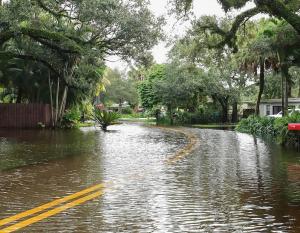Leave No Trace provides advice for responsibly returning to natural areas affected by hurricanes and flooding
BOULDER, CO, UNITED STATES, October 21, 2024 /EINPresswire.com/ — Hurricanes Milton and Helene have severely impacted much of the Gulf Coast and Appalachia’s natural beauty. While many of us feel drawn to explore these areas and assess the damage firsthand, it’s crucial to remember that post-disaster landscapes are often dangerous for the people who call these places home and that the natural qualities that make them special are fragile.
Here’s why staying away is essential in the aftermath of a disaster and how the 7 Principles of Leave No Trace can help support cherished places during their recoveries.
Hidden Dangers in Damaged Areas
After a major natural disaster—whether it’s a hurricane, wildfire, or flood—parks, trails, and beaches are fraught with hidden hazards that make them unsafe for exploration. Even if an area appears passable at first glance, the dangers are often lurking out of sight:
-Landslides and Erosion: Saturated soils can give way unexpectedly, causing landslides that can sweep hikers off their feet. This not only damages trails but puts visitors in life-threatening situations.
– “Widow-makers”: Overhead Weak or damaged trees and hanging branches, known as “widow-makers,” can fall without warning. Even a light breeze can dislodge debris, endangering anyone below.
– Unmarked Trails: Many trails lose crucial markers and signs after severe weather, leading to disorientation or straying into hazardous zones like flood-prone areas.
– Infrastructure Damage: Bridges, boardwalks, and fences might have been washed away or weakened, making once-reliable paths impassable.
– Suspect Water Sources: Well after surface-level floodwaters have retreated, below-ground water supplies may remain compromised. If flooding is a known issue, check with local officials about water safety.
As outdoor enthusiasts, we are responsible for protecting ourselves and avoiding placing an additional or unnecessary strain on local resources. This ties directly into Leave No Trace’s Principle #1: Plan Ahead and Prepare, which reminds us to research current conditions and understand that some areas may not be safe or accessible after natural disasters. Venturing into unstable landscapes without proper information is irresponsible and may put first responders at risk.
Respect Local Communities
After natural disasters, local first responders and emergency workers are stretched thin, providing essential services—rescuing residents, restoring power, and keeping roads safe. In the backcountry, the risk of injury or getting lost increases exponentially, meaning recreational visitors might need rescue assistance. Every call-out for a backcountry rescue diverts attention and resources from critical recovery efforts elsewhere, and it’s important to remember that when resources are diminished, there may be no backcountry rescues available.
This directly relates to Leave No Trace’s Principle #7: Be Considerate of Other Visitors. In times of crisis, “visitors” aren’t just other hikers or tourists; they include local communities and emergency personnel. By staying out of hazardous areas, we respect the needs of first responders, ensuring they can focus on lifesaving efforts without the added burden of preventable rescues. Furthermore, giving communities and nature the space they need to recover without the rush of visitors can provide much-appreciated grace at a time when natural disasters are traumatizing for residents and first responders who experience the devastation firsthand.
Historical examples remind us just how precarious these situations include:
– After Hurricane Harvey in 2017, visitors to the Texas coastline were caught in unexpected secondary flooding, forcing first responders to perform dangerous rescues. Similarly, following the 2004 Indian Ocean Tsunami, rescuers had to aid travelers who underestimated post-disaster risks, redirecting efforts from local recovery.
– These cases remind us that recovery takes time, and rushing into damaged areas only worsens the situation for visitors and the recovery process. Because the benefits of properly following visitor guidelines post-disaster can prove valuable to communities.
– Following Hurricane Katrina in 2005, restoration work included restoring fisheries, recreation, and other ecosystem-based aspects of the local economy.
How to Support Damaged Parks and Trails
Though staying away is the responsible choice, there are plenty of ways you can help these beloved places recover, both now and in the future:
– Volunteer when it’s safe: Many organizations, including Leave No Trace, local park services, and outdoor nonprofits, organize trail recovery and clean-up efforts. Signing up for these events once areas are deemed safe is a tangible way to give back.
– Practice regenerative tourism: Beyond simply minimizing our impact on the environment, regenerative tourism seeks to improve the areas we visit, ensuring that our presence actively contributes to the healing and betterment of these landscapes. Once it’s safe, volunteers can help restore damaged areas, plant native vegetation, and rebuild trail infrastructure, leaving the landscape in better shape than before the disaster.
– Donate to conservation efforts: Financial support is critical. Donations to groups focusing on conservation, restoration, and wildlife protection can speed up recovery efforts.
– Follow recovery updates: Stay informed by following local parks, recreation authorities, and conservation organizations for updates on when areas will be safe to visit again. They often provide specific guidance on how volunteers can assist and when. Seek out reputable organizations to donate your time and resources rather than troubling community members with requests for how you can help.
– Spread the word: As advocates for responsible outdoor recreation, we must educate others about the importance of staying off trails and beaches during recovery efforts. Share this message with your networks, encouraging others to give these areas time to heal.
Mark Eller
Leave No Trace
+1 970-948-0827
[email protected]
Visit us on social media:
Facebook
LinkedIn
Instagram
YouTube
Legal Disclaimer:
EIN Presswire provides this news content “as is” without warranty of any kind. We do not accept any responsibility or liability
for the accuracy, content, images, videos, licenses, completeness, legality, or reliability of the information contained in this
article. If you have any complaints or copyright issues related to this article, kindly contact the author above.
![]()




